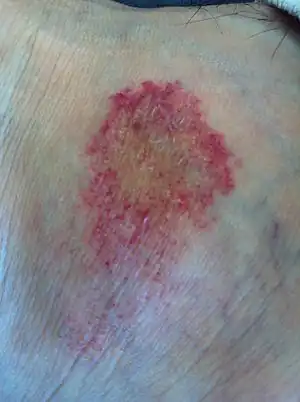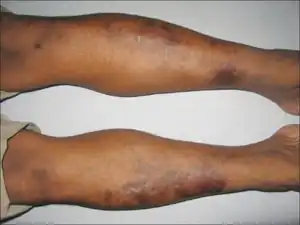Majocchi's disease
| Majocchi's disease | |
|---|---|
 | |
| Purpura annularis telangiectodes | |
Majocchi's disease, also known as Purpura annularis telangiectodes of Majocchi[1] is a not-well-recognized and uncommon skin condition characterized by purple/bluish-red 1- to 3-cm annular patches composed of dark red telangiectases with petechiae. It is one of a group of disorders referred to as pigmented purpuric dermatosis that all occur as a result of vascular inflammation and pigment deposition.[2]: 829
Majocchi's disease is a chronic condition for which there is no cure. It often follows a recurrent course of alternating improvement and flares. There are treatments available to help improve the symptoms for some individuals, but responses vary. Some of these treatments include the application of topical steroids and ultraviolet therapy. The use of narrowband UVB and psoralen have shown to be effective treatments for some patients with pigmented purpuric dermatoses.[3]

References
- ↑ Rapini, Ronald P.; Bolognia, Jean L.; Jorizzo, Joseph L. (2007). Dermatology: 2-Volume Set. St. Louis: Mosby. ISBN 1-4160-2999-0.
- ↑ James, William D.; Berger, Timothy G.; et al. (2006). Andrews' Diseases of the Skin: clinical Dermatology. Saunders Elsevier. ISBN 0-7216-2921-0.
- ↑ Dhali, Tapan Kumar; Chahar, Monica; Haroon, Mohammad Asad (2015). "Phototherapy as an effective treatment for Majocchi's disease - Case report". Anais Brasileiros de Dermatologia. 90 (1): 96–99. doi:10.1590/abd1806-4841.20153067. ISSN 0365-0596. PMC 4323703. PMID 25672304.